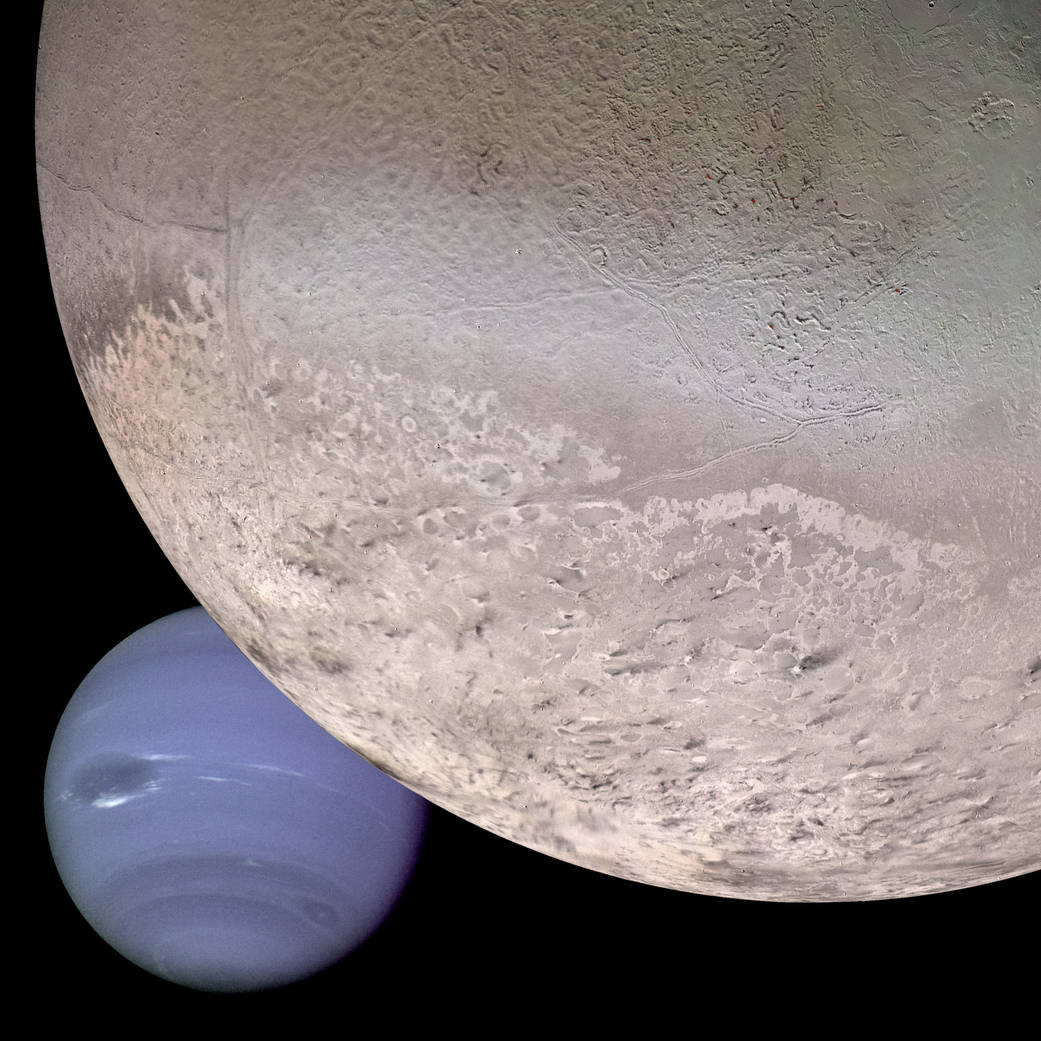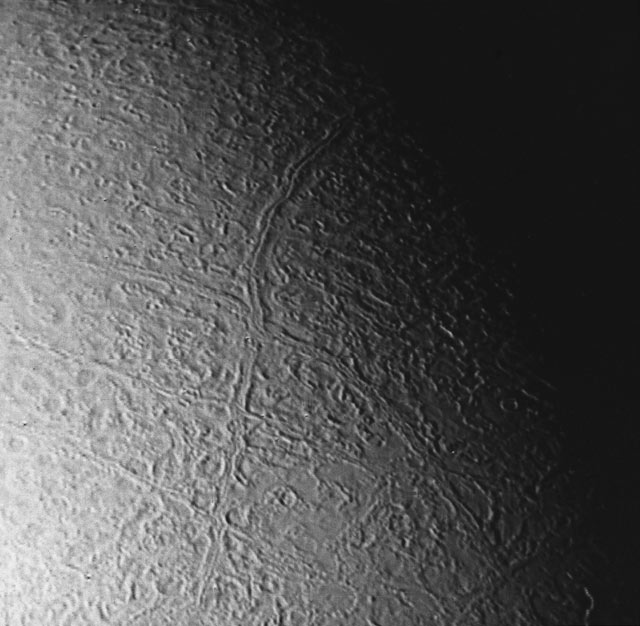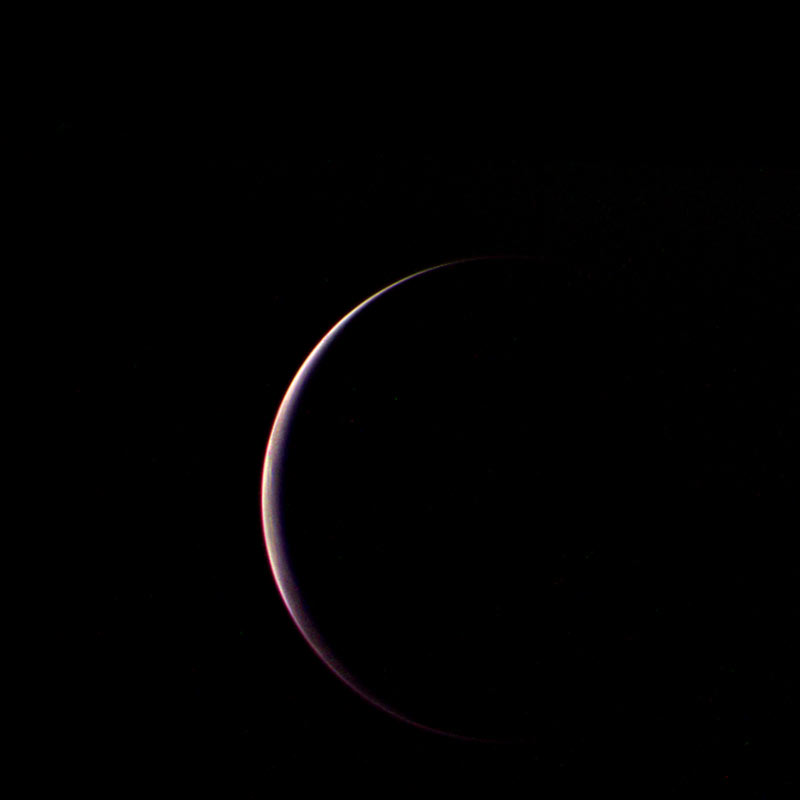The Mysterious Triton Neptune’s Largest Moon
A Captured Frozen World
Discovered in 1846 shortly after Neptune was, Triton is the largest moon of the planet Neptune and is the only large moon in the solar system that orbits in the opposite direction to its planet’s rotation! Appropriately, it was named after the Greek sea god who is the son of the Roman God Neptune!
Fast Summary Facts About Triton!
- Discovered: October 10th, 1846 by William Lassell
- Name: From Greek mythology, Triton is the sea god, son of Poseidon
- Size: Diameter of 2,707 km (1,700 miles)
- Moon Rank: 7th Largest in the solar system
- Orbit: Retrograde and circular
- Orbit Radius: 354,759 km from Neptune’s cloud tops
- Orbital Period: 5 days, 21 hours 2 mins
- Orbital Speed: 4.39 km/sec
- Density: 2.061 g/cm3
- Surface Temperature: A chilly -235 °C (38K)
- Surface: A water-ice crust with predominately frozen nitrogen surface
- Atmosphere: Thin & mostly Nitrogen that is 1/70,000 the thickness of Earths!
More Cool Fun Facts About Intriguing Triton!
- Triton is one of 14 known moons that orbit Neptune, but it is overwhelmingly the largest moon accounting of over 99.5% of the system’s total mass – including its faint rings! Scientists believe this maybe due to the elimination of Neptune’s original moons during the distribution which occurred after Triton's capture.
- There was little detail known about the 7th largest moon in the solar system until the Voyager 2 spacecraft made its flyby in 1989 which came within 40,000 km of Triton.
- An extra interesting fact is that Triton has more mass than all the known moons in the solar system that are smaller than it – combined! This means there is a big step down in the mass (a.k.a size) from the first 7 moons to the remaining moons!
- Triton’s retrograde orbit (and high inclination of 157°) around Neptune is unique in the solar system for a large moon.
- Like many of the large moons, Triton is ‘tidally locked’ to Neptune as it orbits, meaning if you were on the surface you can only ever see Neptune from one side and it never moves position in the sky. This is similar to Earth’s Moon!
- Due to tidal forces associated with Triton's retrograde orbit, the moon is gradually getting closer and scientist predict that in approximately 3.6 billion years Triton will pass within Neptune's Roche limit which will result in a collision or it will disintegrate forming a new ring system similar to Saturn’s Rings! Is this how Saturn’s rings were formed I wonder?
- It is believed that Triton must have formed elsewhere in the solar system, most likely the Kuiper belt as it has a very similar density, temperature and chemical composition to Pluto which is the largest member of the Kuiper belt.
- Based on what we know about Triton's inner structure, it’s believed that there is a core of rock and metal with an outer mantle of water ice as hard as rock! There is some suspicion that the inner heat from radioactive decay maybe even sufficient to support a subsurface ocean as is suspected on other moons such as Europa, Callisto, Ganymede and Enceladus.
- There are extreme seasons throughout a Neptunian year because the polar regions take turns facing the Sun – similar to the planet Uranus! This has an impact on the surface process and geology.
- We have only been able to study 40% of Triton's surface, but it’s notable for the low number of impact craters (Voyager 2 only found 179) which implies its surface is extremely young due to constant modification by ongoing geological activity. This means Triton is one of three moons known to have active geological activity (along with Io and Enceladus).
- Almost the whole surface of Triton is the result of internal geological processes evident by complex valleys and ridges, in all probability the result of tectonics and icy volcanism. How Cool!!
- Voyager 2 observed several geyser-like eruptions with plumes up to 8 km high. The entrained dust made visible dark streaks downwind for over 100km! Wow, I’d love to visit and see these incredible geysers!
- One part of the surface has a series of fissures and depressions known as "cantaloupe terrain" named after its resemblance to the skin of a cantaloupe melon! This type of feature has only been observed on Triton!
- Unfortunately, there are no current missions planned by NASA to visit Neptune and Triton, so we may have to wait several decades to learn more about this enigmatic world!











Triton's Orbit
Triton
Triton
Neptune From Triton
Dark Streaks
Triton Depressions
Triton's Faults
Triton's Surface
Dark Areas
Triton Arc
Relative Mass















